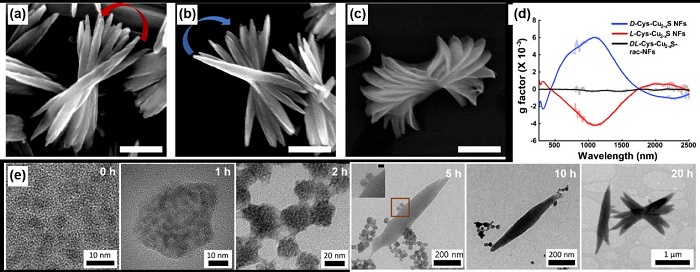research
Researchers observed a wide window of chiroptical activity from nanomaterials
A research team transferred chirality from the molecular scale to a microscale to extend material platforms and applications. The optical activity from this novel chiral material encompasses to short-wave infrared region.
This platform could serve as a powerful strategy for hierarchical chirality transfer through self-assembly, generating broad optical activity and providing immense applications including bio, telecommunication, and imaging technique. This is the first observation of such a wide window of chiroptical activity from nanomaterials.
“We synthesized chiral copper sulfides using cysteine, as the stabilizer, and transferring the chirality from molecular to the microscale through self-assembly,” explained Professor Jihyeon Yeom from the Department of Materials Science and Engineering, who led the research. The result was reported in ACS Nano on September 14.
Chiral nanomaterials provide a rich platform for versatile applications. Tuning the wavelength of polarization rotation maxima in the broad range is a promising candidate for infrared neural stimulation, imaging, and nanothermometry. However, the majority of previously developed chiral nanomaterials revealed the optical activity in a relatively shorter wavelength range, not in short-wave infrared.

< Figure 1. Self-assembly of Cu2S NPs to NFs and chiroptical properties of NFs. (a-c) Scanning electron microscopy (SEM) images of NFs assembled from (a) L-Cys-, (b) D-Cys-, and (c) DL-Cys-Cu2S NPs. (d) Circular Dichroism (CD) spectra of NFs shown in (a-c), which shows chiroptical activity in the UV-SWIR region. (e) Transmission electron microscopy (TEM) images of different stages during NFs formation, NPs (0 h) assembled into NFs (20 h) through supraparticles (1 h, 2 h) and nanoleaves (5 h, 10 h). >
To achieve chiroptical activity in the short-wave infrared region, materials should be in sub-micrometer dimensions, which are compatible with the wavelength of short-wave infrared region light for strong light-matter interaction. They also should have the optical property of short-wave infrared region absorption while forming a structure with chirality.
Professor Yeom’s team induced self-assembly of the chiral nanoparticles by controlling the attraction and repulsion forces between the building block nanoparticles. During this process, molecular chirality of cysteine was transferred to the nanoscale chirality of nanoparticles, and then transferred to the micrometer scale chirality of nanoflowers with 1.5-2 2 μm dimensions formed by the self-assembly.
“We will work to expand the wavelength range of chiroptical activity to the short-wave infrared region, thus reshaping our daily lives in the form of a bio-barcode that can store vast amount of information under the skin,” said Professor Yeom.
This study was funded by the Ministry of Science and ICT, the Ministry of Health and Welfare, the Ministry of Food and Drug Safety, the National Research Foundation of Korea,the KAIST URP Program, the KAIST Creative Challenging Research Program, Samsung and POSCO Science Fellowship.

< Figure 2. Computational simulations of chiroptical property of NFs. (a) Computational simulation models of NFs. (b) Simulated CD spectra of NFs, which are similar to the experimental results. (c) Simulated chiroptical activity of NFs, which show differential absorption properties (chiroptical activity) of left- and right-circularly polarized light. >
-Publication
Ki Hyun Park, Junyoung Kwon, Uichang Jeong, Ji-Young Kim, Nicholas A.Kotov, Jihyeon Yeom, “Broad Chrioptical Activity from Ultraviolet to Short-Wave Infrared by Chirality Transfer from Molecular to Micrometer Scale," September 14, 2021 ACS Nano (https://doi.org/10.1021/acsnano.1c05888)
-Profile
Professor Jihyeon Yeom
Novel Nanomaterials for New Platforms Laboratory
Department of Materials Science and Engineering
KAIST
- No Data